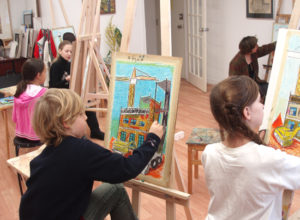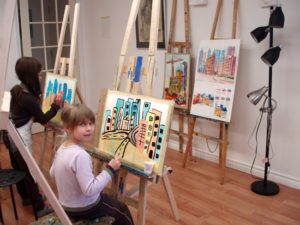Perspective Study in Art
-
Posted by Tanya T in Art Class
 Visual Arts rely on perspective all the time. If you understand perspective well your works will be visual correct, attractive and stand apart greatly. Our students have done many projects on perspective. It’s not an easy subject since it involves geometry, optics and learning new terminology such as viewing point, viewing angle, horizon line, vanishing point, light and shadow points.
Visual Arts rely on perspective all the time. If you understand perspective well your works will be visual correct, attractive and stand apart greatly. Our students have done many projects on perspective. It’s not an easy subject since it involves geometry, optics and learning new terminology such as viewing point, viewing angle, horizon line, vanishing point, light and shadow points.
Students are leaning that the apparent size of an object decreases with increasing distance from the eye – and this is what perspective is all about.
Perspective study has been developing for many centuries. While the main application of perspective is in art, it is an optical phenomenon and thus has its principal root not in art but in geometrical optics.
 We find references to perspective in the books of ancient authors such as Euclid’s Optica, C. 300 B.C. and Ptolemy’s Optica, c. 140 A.D. In his Geographia, c. 140 A.D., Ptolemy applies the principles of geometric optics to the projection of the spherical surface of the earth onto a flat surface, to produce a map. He is said to have made the first known linear perspective construction for drawing a map of the world. Ptolemy apparently knew about perspective, but applied it only to maps and to stage designs.
We find references to perspective in the books of ancient authors such as Euclid’s Optica, C. 300 B.C. and Ptolemy’s Optica, c. 140 A.D. In his Geographia, c. 140 A.D., Ptolemy applies the principles of geometric optics to the projection of the spherical surface of the earth onto a flat surface, to produce a map. He is said to have made the first known linear perspective construction for drawing a map of the world. Ptolemy apparently knew about perspective, but applied it only to maps and to stage designs.
This year we have started several projects on perspective at our art combo class: “Playground” for kids age 5 to 6, “Cityscape” for kids age 7 to 9 and “Construction site” for kids age 10 to 12. Also children are working on the creating variety of geometric shapes in perspective.

